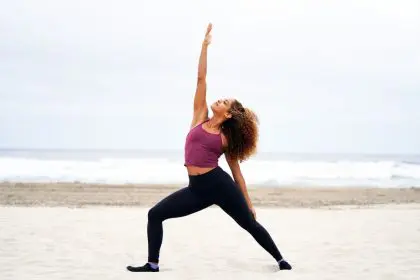Groundbreaking research challenges traditional exercise intensity assumptions

The paradigm shift in exercise science
Slow walking has challenged conventional wisdom about exercise intensity and weight loss, particularly for women in their post-menopausal years, with recent scientific findings revealing surprising benefits. The groundbreaking research published in Nutrients reveals that slower-paced walking may actually optimize fat-burning potential, challenging long-held beliefs about high-intensity workouts and calorie burn.
Understanding the science of slow movement
A comprehensive 30-week study has uncovered surprising metabolic responses to different walking speeds. Researchers have identified that moving at a slower pace may yield better results for fat loss, energy management, and overall well-being. Here’s what they found:
Metabolic efficiency
Slower walking activated optimal fat-burning pathways, making it easier for the body to tap into stored fat for energy. Unlike intense workouts, which can spike adrenaline and stress hormones, a gentle, steady pace promotes a steady metabolic rate that can be maintained longer.
Sustained energy utilization
Gentle movement allows the body to use energy more consistently without the sudden spikes and crashes associated with higher-intensity activities. This approach encourages the body to metabolize fat as a fuel source for longer periods, leading to sustainable weight management.
Hormonal balance
High-intensity exercise can trigger an overproduction of cortisol, a stress hormone that can lead to fat storage, especially around the midsection. Slower walking, however, has been shown to support hormone regulation, helping keep cortisol levels in check and promoting a balanced endocrine system.
Recovery optimization
One of the most underrated aspects of slower-paced walking is how it reduces stress on aging joints and muscles. This allows for regular physical activity without the wear and tear that often leads to chronic pain or injury. It’s a gentle, effective way to stay active and maintain mobility as you age.
The mathematics of movement
The study highlighted not just qualitative findings, but also impressive numerical results that might surprise you:
2.73x more fat loss at slower speeds
Women who maintained a slower pace during their walks experienced nearly three times the fat loss compared to those who engaged in higher-intensity workouts. The key? It’s not about the speed; it’s about how the body processes energy over time.
3.2 miles per hour optimal pace
Researchers found that an optimal walking speed for fat burning and sustainability is approximately 3.2 miles per hour. This pace encourages the body to rely on fat stores without overtaxing the cardiovascular system.
4 sessions per week frequency
Consistency is vital. Walking four times a week proved to be the sweet spot for noticeable fat loss and overall health improvements without excessive strain on the body.
30-week sustained progress
The most impressive part? Women who stuck to the 30-week regimen showed consistent progress, with improvements that extended well beyond the duration of the study.
Practical implementation strategies
Modern research supports several key approaches to incorporating slow walking into daily routines. Here’s how to get started:
Optimal timing patterns
Timing can make a big difference in how your body responds to physical activity. Consider these timing strategies:
- Morning walks for metabolic activation: Kick-start your metabolism by getting outside early. Morning walks can set the tone for the day, promoting energy and boosting mood.
- Post-meal walks for glucose regulation: Taking a short walk after meals can help manage blood sugar levels and prevent insulin spikes, which can be especially helpful for women over 50.
- Evening walks for stress reduction: After a long day, a leisurely evening walk can lower stress levels and improve sleep quality.
- Weekend longer-duration sessions: Dedicate time during weekends for longer walks to maximize the benefits and recharge for the week ahead.
Environmental considerations
To stay committed to a slow walking routine, it’s essential to create an environment that encourages it:
- Choose flat, even terrain for safety: This reduces the risk of injury and ensures a comfortable walking experience.
- Select scenic routes for engagement: Walking in a beautiful environment can make the activity feel less like exercise and more like a leisurely adventure.
- Consider indoor options for weather flexibility: When the weather isn’t ideal, find a treadmill or an indoor walking track.
- Create convenient walking circuits: Plan routes that start and end near your home or workplace, making it easier to incorporate walks into your day.
Progress monitoring
Tracking your results helps you stay motivated and adjust your routine as needed:
- Regular measurements of progress: Weigh yourself or measure waist circumference monthly to see changes over time.
- Consistent pace monitoring: Use a fitness tracker or smartphone app to keep your pace steady and within the optimal range.
- Weekly distance tracking: Log your weekly mileage to ensure you’re meeting your goals.
- Monthly health assessments: Note changes in energy, mood, and overall health to see how slow walking is benefiting you.
Looking forward
The positive outcomes of slow walking don’t stop at just physical health. Emerging research continues to explore new benefits, including:
Cognitive function improvement
The gentle activity of walking promotes blood flow to the brain, potentially enhancing cognitive function and memory retention.
Balance enhancement
Regular walking helps improve balance and coordination, which can reduce the risk of falls, a common concern for older adults.
Social connection opportunities
Walking groups are a great way to meet people and stay motivated. Social interaction has its own set of health benefits, contributing to mental well-being.
Stress reduction capabilities
Walking at a moderate, slower pace can be a moving meditation that helps clear your mind and reduce stress.
Slow walking might just be the secret ingredient for long-lasting health and well-being. It’s time to rethink the way we move and start enjoying the journey, one step at a time.













